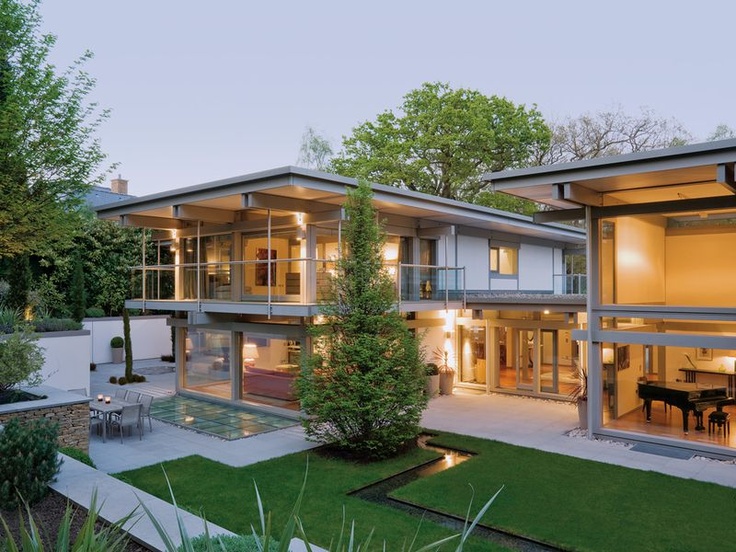Known for their ability to make even the most sanguine and creative of estate agents turn a lighter shade of pale, flat roofs have something of a poor reputation.
Considered leaky, high maintenance, potentially lacking stability and ultimately costly, this poor reputation is not as deserved as it seems.
Yes, older flat roofs can be problematic; those built in the mid-twentieth century were not always the best constructed.
However, before dismissing the flat roof completely, it’s worth considering the fact that they have been (and still can be) found adorning stately homes, palaces and cathedrals.
The rich (liking to stay that way) love flat roofs simply because they can cover large areas in the most cost effective way and in terms of maintenance are also far easier to access.
Lead roofing is common on these older, grander buildings, but alongside lead roofing a whole range of new technologies has created excellent opportunities for modern day domestic properties.
Flat roofs are, in fact, easy to maintain, once in place, and in modern architectural terms offer a lot of innovative possibilities on the design front.
DIY maintenance is possible, and relatively safe compared to the pitched variety, while apart from creating sleek modern lines they offer the possibility of creating roof terraces or gardens as extra outdoor space.
Traditional Materials and Modern Miracles
Poor building practices in the past are one of the reasons for the bad reputation of the flat roof.
With modern building techniques and regulations this issue has largely been addressed.
Flat roofs are not, in fact, flat but pitched ever so slightly. A certain amount of skill is required to create this barely perceptible slope but, done correctly, it will mean that problems are not built in to the roof.
The structure itself is made up of joints, a covering, insulation and a deck.
In addition drainage, guttering and flashing are all part of the structure and help to remove water.
Waterproofing layers cover the structural deck of the roof and there are a number of traditional materials as well as new alternatives.
The most common, in the past, have been felt roofing and sheet metals. Zinc, steel, copper and lead roofing have all been utilised in the past to create long lasting waterproofing.
Modern coverings include a number of rubber solutions, with EPDM rubber being considered one of the most robust.
For those undertaking renovation projects there are a number of choices when it comes to dealing with a flat roof, while for those creating stunning modern buildings the same choices apply.
Doer Upper or Forever Home?
Dealing with a problem flat roof effectively depends on your aims and circumstances.
If you’re planning to move on and want the roof in good repair before attempting to sell, the obvious solution is to repair rather than replace.
If the roof has been reasonably well cared for (and is structurally sound) this approach is the most cost effective and you should, depending on the material, be able to complete the repairs yourself.
If you plan to stay in the property for some time this approach can also work but you may have to spend more time in the future dealing with minor issues; in this case a new waterproof covering may be best option.
If the roof is in a good condition, the new covering can be placed on top of the old, either as a fairly major DIY project or with the help of specialist firms, such as Marcus Roofing.
If you’re planning on spending the rest of your life in the property then older flat roofs may need to be replaced.
Compared to installing or replacing pitched roofs the cost is likely to be significantly less and with modern materials the roof can be potentially a “forever roof” for your forever home.
Covering Choices for Full Replacements
The choice of new covering for your flat roof also depends on your plans. For those moving on in the near future, a felt roof is likely to be the cheapest option.
Felt roofs have an anticipated lifespan of at least fifteen years and installed by professionals this should be longer.
EDPM coverings are popular with householders and flat roofing firms; one of the more recent developments they’re ideal for those planning to stay in the property for the longer term with lifespan of twenty five years and upwards (some manufacturers claim forty years or more).
For a ‘forever’ home, and those willing to invest to create their dream home, lead roofing (or other metal sheet coverings) should be the first consideration.
These have long life expectancy and if well maintained should outlive you!
They’re likely to be the most expensive option, but it’s unlikely that they will be either costly to maintain or need replacement, however long you stay in the property, making them over time the most cost effective option.
About the author
Freelance writer and self-builder, Calvin Ford, looks at the surprising virtues of flat roofing.
